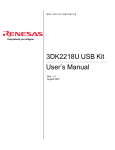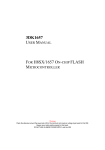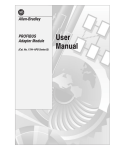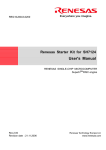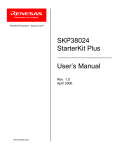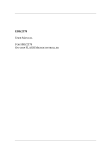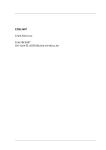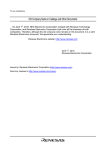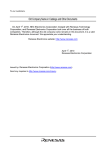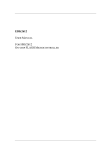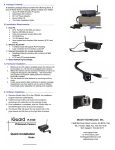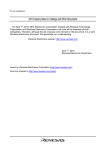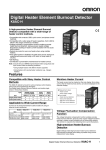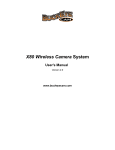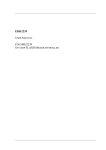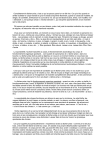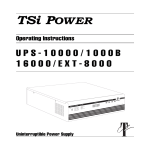Download 3DK38124 User Manual - Digi-Key
Transcript
To our customers, Old Company Name in Catalogs and Other Documents On April 1st, 2010, NEC Electronics Corporation merged with Renesas Technology Corporation, and Renesas Electronics Corporation took over all the business of both companies. Therefore, although the old company name remains in this document, it is a valid Renesas Electronics document. We appreciate your understanding. Renesas Electronics website: http://www.renesas.com April 1st, 2010 Renesas Electronics Corporation Issued by: Renesas Electronics Corporation (http://www.renesas.com) Send any inquiries to http://www.renesas.com/inquiry. Notice 1. 2. 3. 4. 5. 6. 7. All information included in this document is current as of the date this document is issued. Such information, however, is subject to change without any prior notice. Before purchasing or using any Renesas Electronics products listed herein, please confirm the latest product information with a Renesas Electronics sales office. Also, please pay regular and careful attention to additional and different information to be disclosed by Renesas Electronics such as that disclosed through our website. Renesas Electronics does not assume any liability for infringement of patents, copyrights, or other intellectual property rights of third parties by or arising from the use of Renesas Electronics products or technical information described in this document. No license, express, implied or otherwise, is granted hereby under any patents, copyrights or other intellectual property rights of Renesas Electronics or others. You should not alter, modify, copy, or otherwise misappropriate any Renesas Electronics product, whether in whole or in part. Descriptions of circuits, software and other related information in this document are provided only to illustrate the operation of semiconductor products and application examples. You are fully responsible for the incorporation of these circuits, software, and information in the design of your equipment. Renesas Electronics assumes no responsibility for any losses incurred by you or third parties arising from the use of these circuits, software, or information. When exporting the products or technology described in this document, you should comply with the applicable export control laws and regulations and follow the procedures required by such laws and regulations. You should not use Renesas Electronics products or the technology described in this document for any purpose relating to military applications or use by the military, including but not limited to the development of weapons of mass destruction. Renesas Electronics products and technology may not be used for or incorporated into any products or systems whose manufacture, use, or sale is prohibited under any applicable domestic or foreign laws or regulations. Renesas Electronics has used reasonable care in preparing the information included in this document, but Renesas Electronics does not warrant that such information is error free. Renesas Electronics assumes no liability whatsoever for any damages incurred by you resulting from errors in or omissions from the information included herein. Renesas Electronics products are classified according to the following three quality grades: “Standard”, “High Quality”, and “Specific”. The recommended applications for each Renesas Electronics product depends on the product’s quality grade, as indicated below. You must check the quality grade of each Renesas Electronics product before using it in a particular application. You may not use any Renesas Electronics product for any application categorized as “Specific” without the prior written consent of Renesas Electronics. Further, you may not use any Renesas Electronics product for any application for which it is not intended without the prior written consent of Renesas Electronics. Renesas Electronics shall not be in any way liable for any damages or losses incurred by you or third parties arising from the use of any Renesas Electronics product for an application categorized as “Specific” or for which the product is not intended where you have failed to obtain the prior written consent of Renesas Electronics. The quality grade of each Renesas Electronics product is “Standard” unless otherwise expressly specified in a Renesas Electronics data sheets or data books, etc. “Standard”: 8. 9. 10. 11. 12. Computers; office equipment; communications equipment; test and measurement equipment; audio and visual equipment; home electronic appliances; machine tools; personal electronic equipment; and industrial robots. “High Quality”: Transportation equipment (automobiles, trains, ships, etc.); traffic control systems; anti-disaster systems; anticrime systems; safety equipment; and medical equipment not specifically designed for life support. “Specific”: Aircraft; aerospace equipment; submersible repeaters; nuclear reactor control systems; medical equipment or systems for life support (e.g. artificial life support devices or systems), surgical implantations, or healthcare intervention (e.g. excision, etc.), and any other applications or purposes that pose a direct threat to human life. You should use the Renesas Electronics products described in this document within the range specified by Renesas Electronics, especially with respect to the maximum rating, operating supply voltage range, movement power voltage range, heat radiation characteristics, installation and other product characteristics. Renesas Electronics shall have no liability for malfunctions or damages arising out of the use of Renesas Electronics products beyond such specified ranges. Although Renesas Electronics endeavors to improve the quality and reliability of its products, semiconductor products have specific characteristics such as the occurrence of failure at a certain rate and malfunctions under certain use conditions. Further, Renesas Electronics products are not subject to radiation resistance design. Please be sure to implement safety measures to guard them against the possibility of physical injury, and injury or damage caused by fire in the event of the failure of a Renesas Electronics product, such as safety design for hardware and software including but not limited to redundancy, fire control and malfunction prevention, appropriate treatment for aging degradation or any other appropriate measures. Because the evaluation of microcomputer software alone is very difficult, please evaluate the safety of the final products or system manufactured by you. Please contact a Renesas Electronics sales office for details as to environmental matters such as the environmental compatibility of each Renesas Electronics product. Please use Renesas Electronics products in compliance with all applicable laws and regulations that regulate the inclusion or use of controlled substances, including without limitation, the EU RoHS Directive. Renesas Electronics assumes no liability for damages or losses occurring as a result of your noncompliance with applicable laws and regulations. This document may not be reproduced or duplicated, in any form, in whole or in part, without prior written consent of Renesas Electronics. Please contact a Renesas Electronics sales office if you have any questions regarding the information contained in this document or Renesas Electronics products, or if you have any other inquiries. (Note 1) “Renesas Electronics” as used in this document means Renesas Electronics Corporation and also includes its majorityowned subsidiaries. (Note 2) “Renesas Electronics product(s)” means any product developed or manufactured by or for Renesas Electronics. To all our customers Regarding the change of names mentioned in the document, such as Hitachi Electric and Hitachi XX, to Renesas Technology Corp. The semiconductor operations of Mitsubishi Electric and Hitachi were transferred to Renesas Technology Corporation on April 1st 2003. These operations include microcomputer, logic, analog and discrete devices, and memory chips other than DRAMs (flash memory, SRAMs etc.) Accordingly, although Hitachi, Hitachi, Ltd., Hitachi Semiconductors, and other Hitachi brand names are mentioned in the document, these names have in fact all been changed to Renesas Technology Corp. Thank you for your understanding. Except for our corporate trademark, logo and corporate statement, no changes whatsoever have been made to the contents of the document, and these changes do not constitute any alteration to the contents of the document itself. Renesas Technology Home Page: http://www.renesas.com Renesas Technology Corp. Customer Support Dept. April 1, 2003 3DK38124 USER MANUAL FOR H8/38124 ON-CHIP FLASH MICROCONTROLLER Warning Check the silkscreen around the power jack (J9) for the minimum and maximum voltage input levels for this 3DK. Always use a centre positive supply for this board. DO NOT USE AN E6000 POWER SUPPLY with this 3DK Preface Cautions 1. This document may be, wholly or partially, subject to change without notice. 2. All rights reserved. No one is permitted to reproduce or duplicate, in any form, a part or this entire document without Renesas Technology Europe Limited's written permission. Trademarks General All brand or product names used in this manual are trademarks or registered trademarks of their respective companies or organisations. Document Information Product Code: D005610_11 Version: 1 Date: 22/11/2004 Copyright © Renesas Technology Europe Ltd. 2004. All rights reserved. Website: http://www.eu.renesas.com/ TABLE OF CONTENTS TABLE OF CONTENTS .......................................................................................................................................................3 1. POWER REQUIREMENTS ..........................................................................................................................................4 2. POWER – UP BEHAVIOUR ........................................................................................................................................4 3. PURPOSE ...............................................................................................................................................................4 4. BOARD LAYOUT ......................................................................................................................................................4 5. BLOCK DIAGRAM ....................................................................................................................................................6 6. USER CIRCUITRY ....................................................................................................................................................6 6.1. SWITCHES...........................................................................................................................................................6 6.2. LEDS ....................................................................................................................................................................6 6.3. SERIAL PORT ......................................................................................................................................................7 6.4. JUMPERS.............................................................................................................................................................7 7. OSCILLATOR SOURCES ...........................................................................................................................................8 8. MODES ...................................................................................................................................................................8 8.1. BOOT MODE........................................................................................................................................................8 8.2. USER MODE ........................................................................................................................................................8 9. PROGRAMMING METHODS .......................................................................................................................................8 9.1. PORT PROGRAMMING.......................................................................................................................................9 9.2. FDM HEADER ......................................................................................................................................................9 9.3. E7 HEADER..........................................................................................................................................................9 9.4. OFF-BOARD PROGRAMMING............................................................................................................................9 10. HEADERS ...............................................................................................................................................................9 10.1. MICON HEADERS................................................................................................................................................9 10.2. GENERIC HEADERS .........................................................................................................................................10 11. CODE DEVELOPMENT ............................................................................................................................................11 11.1. OVERVIEW ........................................................................................................................................................11 11.2. MODE SUPPORT...............................................................................................................................................11 11.3. BREAKPOINT SUPPORT ..................................................................................................................................11 11.4. CODE LOCATED IN RAM..................................................................................................................................11 11.5. HMON CODE SIZE.............................................................................................................................................11 11.6. MEMORY MAP...................................................................................................................................................12 11.7. BAUD RATE SETTING.......................................................................................................................................13 11.8. INTERRUPT USAGE..........................................................................................................................................13 11.9. ADDITIONAL INFORMATION ............................................................................................................................13 1. POWER REQUIREMENTS All 3DK boards are centre positive with a 2.5mm barrel power jack. The diode, D1 provides reverse polarity protection. A 9V, centre positive supply is suitable for use with this board. Warning Check the silkscreen around the power jack (J9) for the minimum and maximum voltage input levels for this 3DK. The 3DK is neither under nor over voltage protected. Always use a centre positive supply for this board. DO NOT USE AN E6000 POWER SUPPLY with this 3DK 2. POWER – UP BEHAVIOUR The 3DK board has code pre-programmed into the Renesas microcontroller. On powering up the board, the red user LEDs will start to flash. Switches 2 and 3 as well as the potentiometer can be used to modify the LED flashing pattern. 3. PURPOSE This 3DK board is an evaluation tool for Renesas microcontrollers. Features include: a. Renesas Microcontroller Programming b. User Code Debugging c. User Circuitry such as Switches, LEDs and potentiometer(s) d. User or Base Board Connectivity The 3DK board contains all the circuitry required for microcontroller operation. 4. BOARD LAYOUT The following diagram shows the component layout top layer component of the board. Note: The diagram below is for illustrative purposes and does not accurately reflect the 3DK detailed in this manual. RES J3 DEBUG U1 OFF USER SWITCHES ON MICON HEADER J2 MICON HEADER J3 MCU_SEL FLASH HEADER J4 19-WAY GENERIC HEADER J5 MCU SELECT SWITCH SW3 SERIAL PORT CLED8 CLED7 Renesas Microcontroller J8 CLED6 SW2 CLED5 CLED4 BOOTJ7 USER LEDS J12 CLED3 J2 POWER JACK SW1/BOOT J5 J6 CLED2 J9 CLED1 BOOT LED J1 BOOT MICON SINGLE TURN HEADER POTENTIOMETER J4 MICON HEADER J1 DEBUG HEADER 20-WAY GENERIC HEADER J6 The following diagram shows the component layout bottom layer component of the board. Note: The diagram below is for illustrative purposes and does not accurately reflect the 3DK detailed in this manual. RS232 Transceiver IC BOOT LATCH U2 C 2004 Renesas Technology Europe LTD. HC74 dual D-type logic U5 Crystal / Oscillator / Resonator Components / Footprints U6 PCB Component Placing Top PCB Component Placing Bottom Regulator IC 5. BLOCK DIAGRAM Diagram 5.1 is representative of the 3DK components and their connectivity. Power Jack & Regulator IC Generic Headers Microcontroller Boot mode pins Flash/Boot Header Micon Headers RESET pin Boot Circuitry RESn D-type latch BOOT & BOOTn signals IRQ pin IRQ pin IRQ pin Serial Connector Debug Header SW2 RES SW3 BOOT SWITCHES LEDs 3 Red LEDS 1 Green LED 6. USER CIRCUITRY 6.1. SWITCHES There are four switches located on the 3DK. These are: Switch Function Microcontroller SW1/BOOT This switch is used in conjunction with the RES switch to place the device in BOOT mode. SW2 This switch is connected via a 0R link to an IRQ line capable of waking up the microcontroller device from sleep mode. SW3 This switch is connected via a 0R link to another IRQ line capable of waking up the microcontroller device from sleep mode. RES This switch when pressed resets the 3DK microcontroller. NB. Refer to schematic for detailed connectivity information. IRQ0 (Port 4 –3) IRQ4 (Port 1 –4) IRQ3 (Port 1 – 7) RESn 6.2. LEDS There are four LEDs on the 3DK board. The green BOOT LED indicates the device is in boot mode when lit. The three red LEDs are connected to an IO port and will light when their corresponding port pin is set low. Table 6-1, below, shows the LED pin references and their corresponding microcontroller port pin connections. LED Reference (As shown on silkscreen) CLED1 CLED2 CLED3 Microcontroller Port Pin function Port 9 – 0 Port 9 – 1 Port 9 – 2 Table 6-1:LED Port Microcontroller Pin Number 54 55 56 6.3. SERIAL PORT The microcontroller programming serial port (SCI3) is connected to the D–type connector J8 via an RS232 transceiver. The serial baud rates supported by this 3DK are shown below. Note: these values are calculated from the frequency value of the main oscillating source fitted by default on this 3DK. Baud Rate Register Settings for Serial Communication Rates Values are calculated for 9.8304MHz clock SMR Setting: Comm. Baud 0 BRR setting Actual Rate 1 ERR (%) 110 Invalid Invalid Invalid 300 Invalid Invalid Invalid BRR setting 2 Actual Rate Invalid Invalid ERR (%) BRR setting Invalid 3 Actual Rate ERR (%) BRR setting Actual Rate ERR (%) 86 110.3 0.31 21 109 -0.83 127 300 0.00 31 300 0.00 7 300 0.00 0.00 1200 127 1200 0.00 31 1200 0.00 7 1200 0.00 1 1200 2400 63 2400 0.00 15 2400 0.00 3 2400 0.00 0 2400 4800 31 4800 0.00 7 4800 0.00 1 4800 0.00 Invalid Invalid Invalid 9600 15 9600 0.00 3 9600 0.00 0 9600 0.00 Invalid Invalid Invalid 19200 7 19200 0.00 1 19200 0.00 Invalid Invalid Invalid Invalid Invalid Invalid 38400 3 38400 0.00 0 38400 0.00 Invalid Invalid Invalid Invalid Invalid Invalid 57600 2 51200 -11.11 Invalid Invalid Invalid Invalid Invalid Invalid Invalid Invalid Invalid 0 153600 33.33 Invalid Invalid Invalid Invalid Invalid Invalid Invalid Invalid Invalid 115200 0.00 Table 6-2 : BRR Settings This serial port may be used as a debugging communication port or as a normal serial communication port when the device is in user mode. 5 4 9 3 8 2 7 1 6 Female serial connector showing pin numbering Power Jack 6.4. JUMPERS Table 6-3 below describes the function of the 2-Pin jumpers contained on this 3DK board. 2-Pin Jumper Settings Reference Jumper Function Fitted Alternative (Removed) J10 RX Disable PRXD from the RS232 device to U1 is enabled. This enables serial port communication. Disabled. This allows the FDM to program the microcontroller Jumper pins fitted J11 UVCC power Measurement Bypasses R11, a 1206 0R resistor, for current measurement R11 must be fitted to power UVCC Footprint only Table 6-4: 2-Pin jumpers Footprint for jumper only/Jumper pins fitted 7. OSCILLATOR SOURCES A crystal resonator is fitted on the 3DK and used to supply the main clock input to the Renesas microcontroller. Table 7-1 details the oscillators that are fitted on this 3DK: Component Details Crystal Subclock Yes 9.8304MHz 38400 Yes 32.768 kHz N/A Table 7-1: Oscillators / Resonators Warning: When replacing the default oscillator with that of another frequency, the FDT programming kernels supplied will need rewriting. The supplied HMON debugging monitor will not function. The user is responsible for code written to support operating speeds other than the default. See the HMON user manual for details of making the appropriate modifications in the code to accommodate different operating frequencies. 8. MODES The 3DK supports User mode and Boot mode. User mode may be used to run user code, while Boot mode may be used to program the Renesas microcontroller with program code and to debug code. To enter boot mode, the mode pins are held in their boot states while reset is pressed and released. The BOOT LED will be illuminated to indicate that the microcontroller is in boot mode. 8.1. BOOT MODE The boot mode settings for this 3DK are shown in Table 8-1 below: TEST 0 0 NMI 1 0 P36 X 1 LSI State after Reset End User Mode Boot Mode Table 8-1: Mode pin settings 8.2. USER MODE For the device to enter User Mode, reset must be held active while the microcontroller mode pins are held in states specified for User Mode operation. 100K pull up and pull down resistors are used to set the pin states during reset. The H8/38124 supports only normal mode, which has a 64-kbyte address space. 9. PROGRAMMING METHODS The Flash ROM on the microcontroller can be programmed when the device is in Boot mode. Once in boot mode, the bootloader program stored in the microcontroller executes and attempts a connection with a host (for example, a PC). The host, on establishing a connection with the microcontroller, may then transmit program data to the microcontroller via the appropriate programming port. Table 9-1 below shows the programming port for this Renesas Microcontroller and its associated pins Programming Port Table – Programming port pins and their 3DK signal names SCI3 TXD, PIN 71 RXD_1, PIN 70 3DK Signal Name PTXD PRXD Table 9-1: Serial Port Boot Channel 9.1. BOOT PROGRAMMING The microcontroller must enter boot mode for programming, and the programming port must be connected to a host for program download. To execute the boot transition, and allow programs to download to the microcontroller, the user must perform the following procedure: 1. 2. 3. 4. Connect a 1:1 serial cable between the host PC and the 3DK board Depress the BOOT switch and keep this held down Depress the RESET switch once, and release Release the BOOT switch 9.2. FDM HEADER This 3DK does not support the FDM. 9.3. E7 HEADER The Renesas E7 Debugger is a tool for debugging Renesas microcontrollers, available separately from Renesas. The E7 utilises SCI4 on the microcontroller. The device may be debugged and programmed using the E7. 9.4. OFF-BOARD PROGRAMMING All 3DKs are capable of programming an alternative microcontroller on a secondary board. The user is responsible for providing this second board containing the alternative microcontroller, its supporting circuitry and an FDM or FoUSB header for the microcontroller. To program the alternative microcontroller, the user should perform the following steps • • Connect a cable between the 3DK programming header and that located on the secondary board. Slide switch MCU_SEL to the off-board programming position (OFF). This holds the microcontroller on the 3DK in reset, preventing it from being programmed. 10. HEADERS 10.1. MICON HEADERS Table 10-1 to Table 10-4 shows the micon headers and their corresponding microcontroller connections. The header pins connect directly to the micon pin unless otherwise stated. J1 Pin 1 3 5 7 9 11 13 15 17 19 Circuit Net Name CON_AVCC (AVCC via a 0R link) CON_X2 (X2 via a 0R link) CON_OSC2 (OSC2 via a 0R link) U1 pin number 1 3 5 7 9 11 13 15 17 19 J1 pin number 2 4 6 8 10 12 14 16 18 20 Circuit Net Name CON_X1 (X1 via a 0R link) CON_OSC1 (OSC2 via a 0R link) U1 pin number 2 4 6 8 10 12 14 16 18 20 Table 10-1: J1 J2 Pin 1 3 5 7 9 11 13 15 Circuit Net Name U1 pin number 21 23 25 27 29 31 33 35 J2 pin number 2 4 6 8 10 12 14 16 Circuit Net Name U1 pin number 22 24 26 28 30 32 34 36 17 19 37 39 18 20 38 40 Table 10-2: J2 J3 Pin 1 3 5 7 9 11 13 15 17 19 Circuit Net Name CON_PIN57 (PIN57 via a 0R link) U1 pin number 41 43 45 47 49 51 53 55 57 59 J3 pin number 2 4 6 8 10 12 14 16 18 20 Circuit Net Name U1 pin number 42 44 46 48 50 52 54 56 58 60 Circuit Net Name U1 pin number 62 64 66 68 70 72 74 16 78 80 Table 10-3: J3 J4 Pin Circuit Net Name 1 3 5 7 9 11 13 15 17 19 U1 pin number 61 63 65 67 69 71 73 75 77 79 J4 pin number 2 4 6 8 10 12 14 16 18 20 Table 10-4: J4 10.2. GENERIC HEADERS Table 10-5 below shows the generic header connections 19 way generic Header Pin Number 1 2 3 4 5 6 7 8 9 10 11 12 13 14 15 16 17 18 19 Generic Header Name Supply Xin Vcc Vss Vcc Vss AVcc AVss Vref AN0 AN1 AN2 AN3 DAC0 DAC1 SCL SDA CTX CRX 3DK Signal Name Supply CON_OSC1 VCC1 GROUND VCC2 GROUND AVCC AVSS VREF PIN77 PIN78 PIN79 PIN80 Not Connected Not Connected Not Connected Not Connected Not Connected Not Connected 20 way generic Header Micon Pin N/A 10* N/A N/A N/A N/A 52 53 N/A 77 78 79 79 80 NC NC NC NC NC Pin Number 1 2 3 4 5 6 7 8 9 10 11 12 13 14 15 16 17 18 19 Generic Header Name IOPORT_TXD IOPORT_RXD IOPORT_T1 IOPORT_T2 IOPORT_T3 IOPORT_T4 IOPORT_U IOPORT_V IOPORT_W IOPORT_0 IOPORT_1 IOPORT_2 IOPORT_3 IOPORT_4 IOPORT_5 IOPORT_6 IOPORT_7 /Reset /NMI 3DK Signal Name IOPORT_TXD IOPORT_RXD IOPORT_T1 IOPORT_T2 IOPORT_T3 IOPORT_T4 Not Connected Not Connected Not Connected IOPORT_0 IOPORT_1 IOPORT_2 Not Connected Not Connected Not Connected Not Connected Not Connected RESn IOPORT_INT Micon Pin N/A N/A 63 62 67 68 NC NC NC 54 55 56 NC NC NC NC NC 12 N/A 20 VSS GROUND Table 10-5: Generic Headers * Connected via a DNF 0R Link, refer to schematic for further details. 11. CODE DEVELOPMENT 11.1. OVERVIEW Note: For all code debugging using Renesas software tools, the 3DK board must be connected to a PC serial port via a serial cable. The HMON embedded monitor code is modified for each specific 3DK Renesas Microcontroller. HMON enables HEW to establish a serial connection to the 3DK microcontroller, and control code execution on the microcontroller. The HMON embedded monitor code must be compiled with user software and downloaded to the 3DK, allowing the users’ code to be debugged within HEW. The board must be operated in BOOT mode during debugging. 11.2. MODE SUPPORT The HMON library is built to support Normal Mode only. The Device supports only Normal Mode. 11.3. BREAKPOINT SUPPORT The monitor has an address break controller with one break channel, therefore one breakpoint can be located in ROM. Code located in RAM may have multiple breakpoints limited only by the size of the On-Chip RAM. Due to a limitation of the internal address break controller, a breakpoint set in ROM will execute the instruction at the breakpoint and stop on the subsequent op-code. The break controller only functions in BOOT mode. 11.4. CODE LOCATED IN RAM Double clicking in the breakpoint column in the code sets the breakpoint. Breakpoints will remain unless they are double clicked to remove them. 11.5. HMON CODE SIZE HMON is built along with the debug code. Certain elements of the HMON code must remain at a fixed location in memory. The following table details the HMON components and their size and location in memory. For more information, refer to the map file when building code. Section Description Start Location Size (H’bytes) RESET_VECTOR HMON Reset Vector (Vector 0) Required for Startup of HMON TRAPA Instruction Vector (Vector 8) Required by HMON to create Breakpoints in RAM HMON Break Controller (Vector 10) Required by HMON to create Breakpoints in ROM HMON Serial Port Vectors (Vector 18) Used by HMON when EDK is configured to connect to the default serial port. HMON Code HMON Constant Data HMON Uninitialised data H’ 0000 0000 2 H’ 0000 0010 2 H’ 0000 0014 2 H’ 0000 0024 2 H’ 0000 27f2 H’ 0000 4684 H’ 0000 f780 1e92 e1 1fd H’ 0000 0400 1a8 H’ 0000 2000 5d1 H’ 0000 0100 2 TRAP_VECTORS HW_BREAK_VECTORS SCI_VECTORS PHMON CHMON BHMON FDTInit FDTUserModeMicroKernel CUser_Vectors FDT Init Kernel. This is at a fixed location and must not be moved. Should the kernel need to be moved it must be re-compiled. FDT User Mode Kernel. This is at a fixed location and must not be moved. Should the kernel need to be moved it must be re-compiled. Pointer used by HMON to point to the start of user code. N/A 11.6. MEMORY MAP The memory map shown in this section visually describes the locations of program code sections related to HMON, the FDT kernels and the supporting code within the ROM/RAM memory areas of the microcontroller. H'0000 H'0100 Vectors RESET Vector H'0000 H'0001 TRAP Vector H'0010 H'0011 HW Break Vector H'0014 H'0015 SCI Vectors H'0024 H'0025 CUser_Vectors H'0400 FDTInit H'05A7 H'2000 H'25D0 H'27F2 On-Chip FLASH ROM FDTUserM ode M icroKernel On-Chip FLASH ROM PHM ON CHM ON H'4764 On-Chip FLASH ROM H'7FFF H'F020 Internal I/O REGISTERS H'F02B H'F740 LCD RAM 16 Bytes H'F74F H'F780 H'F9E8 BHM ON 1-kbyte work area for reprogram ing FLASH H'FB7F H'FB80 1k User RAM H'FE80 H'FF7F H'FF80 H'FFFF Stack Internal I/O REGISTERS 11.7. BAUD RATE SETTING HMON is initially set to connect at 38400 Baud. The value set in the baud rate register for the microcontroller must be altered if the user wishes to change either the serial communication baud rate of the serial port or the operating frequency of the microcontroller. This value is held in the HMONserialconfiguser.c file, as SCI_CFG_BRR (see the Serial Port section for baud rate register setting values). The project must be re-built and the resulting code downloaded to the microcontroller once the BRR value is changed. Please refer to the HMON User Manual for further information. 11.8. INTERRUPT USAGE Because HMON uses the serial port, interrupts using a higher priority cannot be used while debugging. In practice this means that only the ADC interrupt can be used reliably during debugging. 11.9. ADDITIONAL INFORMATION For details on how to use High-performance Embedded Workshop (HEW), with HMON, refer to the HEW manual available on the CD or from the web site. For information about the H8/38024-H8/38124 series microcontrollers refer to the H8/38024 Series Hardware Manual For information about the H8/38124 assembly language, refer to the H8 Series Programming Manual Further information available for this product can be found on the Renesas web site at: http://www.eu.renesas.com/tools General information on Renesas Microcontrollers can be found at the following URLs. Global: http://www.renesas.com/
















